Final report for ONE17-304
Project Information
Foliar nutrient sprays are applied by some tomato growers to their determinate tomatoes. There is little peer-reviewed research that supports this relatively common practice. The purpose of this study was to document the effects of foliar fertilizer sprays on ‘Red Deuce’ tomatoes grown on two farm fields (same grower) and one set of experimental plots at the University of Rhode Island. In addition, vegetable growers were surveyed at grower conferences in order to document the degree of popularity of this practice. Foliar nutrient sprays were applied according to the plan of a fertilizer sales representative. The preliminary finding from this project is that foliar nutrient application to field-grown determinate tomatoes did not increase gross yield, net yield or percent marketability of fruits. There were numerous difficulties during the 2017 season and another year of data would be useful to bolster this conclusion. Growers were surveyed on foliar feeding and over 50% reported using some form of this practice. Most of the growers surveyed grow less than one acre of tomatoes. The majority of growers obtain information on foliar feeding from sales representatives and other growers and make their decision to use foliar feeding based on advice and not on any known deficiencies or nutrient testing.
Outreach of results were presented during the tomato session of the 2017 New England Vegetable and Fruit Conference (NEVFC) in Manchester, New Hampshire, on December 14 and again at the University of Connecticut Cooperative Extension Vegetable ad Small Fruit Conference on January 8, 2018.
The aim of this investigation is to improve profitability and environmental sustainability among conventional Rhode Island vegetable growers through examination of fertilizer nutrient delivery to vegetable crops. One hypothesis will be addressed: Routine applications of foliar fertilizers to field-grown determinate tomatoes provide significant return on investment in the form of improved yield and quality. The field research will be a replicated test of this alongside of an untreated control. The procurement of information on this practice by growers is also examined herein by surveying Rhode Island and New England growers in these topics: 1) To what extent do Rhode Island and New England growers use the practice known as Foliar Feeding? 2) How do growers obtain information regarding this practice?
Rhode Island vegetable farmers are under pressure to maximize profits on limited cropland, which is valued among the highest in the country (NASS, 2015). In highly diversified operations on small acreage (<10), per-acre productivity must be maximized for resource use efficiency, but on larger acreages of single crops, input use efficiency is a key factor in sustainability of the enterprise.
There is an ever-growing array of foliar-applied fertilizer and growth-promoting substances which are purported to maximize yield and/or quality. These products are aggressively marketed by purveyors of agricultural inputs. An informal initial survey of conventional Rhode Island growers (N=13) revealed that 53% use foliar nutrients in field conditions routinely in their season long spray programs. Some swear by the practice, others are equivocal. This routine application is in contrast to recommendations in extension literature which advocates use only when nutrient deficiency has been detected through tissue testing or when other limitations to uptake exist (Johnson, 2016; Pettinelli, 2016). High tunnel conditions are different and may warrant the practice when per plant yields of tomatoes exceed 20 lbs. The biostimulant and stress-reducing effects of seaweed extracts are more extensively documented in the literature and reviewed by Craigie (2011) and Kahn et al (2009). Neither the New England Vegetable Management Guide nor the Mid-Atlantic Commercial Production Recommendations advise regular foliar feeding or application of seaweed-based products as part of overall crop management plans, though it is possible they may play important roles in some sets of growing conditions.
In New England, agricultural extension continues to dwindle: since 1990, there has been a significant reduction in agents and specialists working in vegetable crop production. Furthermore, there is one fourth the number of certified crop advisers in all of New England as there are in the state of New York alone (NRCCA). The lack of agricultural service providers presents a vacuum of direct professional service providers for growers, and the opportunity for under-qualified salespeople to advise. Our personal experience and a cause for concern in Rhode Island is that erroneous diagnoses and incorrect and unnecessary applications of fertilizers and crop protection chemicals are made because of uninformed advice.
Citations
USDA, National Agricultural Statistics Service: Land Values 2015 Summary (August 2015)
Johnson, G. Extension Vegetable and Fruit Specialist, University of Delaware. Foliar Fertilization of Vegetable Crops. https://extension.udel.edu/weeklycropupdate/?p=8837.
Pettinelli, Dawn. Foliar Fertilization. UCONN Soil Nutrient Analysis Laboratory http://www.soiltest.uconn.edu/factsheets/FoliarFertilization.pdf
Craigie, J. S. 2011. Seaweed extract stimuli in plant science and agriculture. J Appl Phycol 23:371-393.
Khan, W., U. P. Rayirath, S. Subramanian. 2009. Seaweed extracts as biostimulants of plant growth and development. J Plant Growth Regul 28:386–399.
Northeast Region Certified Crop Advisors (NRCCA).
Cooperators
- (Educator)
Research
Foliar feeding trials
- Trial at URI Agronomy Farm
Field Plots: On May 22, 2017, 64 ‘Red Deuce’ seedlings (supplied by Confreda Farms) were transplanted into each of eight, black-plastic mulch-covered raised beds at a spacing of 24” apart within rows, and 6’ between rows. Planting density was 512 plants on 7,128 sq. ft., which is 3,129 plants per acre. Plants were watered in with high phosphorus starter fertilizer. Drip irrigation tape was rolled out under the mulch as it was being laid. Soil water status was monitored using Watermark sensors installed at 12” and 18” depths at two locations.
Eight treatment plots were marked off at every eight plants, running perpendicular to the row directions (Figure 1). Plots therefore, were 8 rows wide by 8 plants long.
Treatments:
A foliar nutrient spray regimen was applied three times during the growing season to four of the eight plots at the URI Agronomy farm. Spray materials are detailed in Table 1.
Sampling:
1) Fruit harvest data at the URI Agronomy Farm was collected by establishing a 24 plant subsample plot (from the middle 6 rows, 4 plants each) in each of the eight plots, four of which were sprayed and four of which were unsprayed.
2) Leaf tissue samples were collected from the the URI Agronomy plots on three occasions (June 26, July 21 and August 7). Sample material was dried, ground, and submitted for leaf tissue analysis at the University of Connecticut soils laboratory.
- Trial at Confreda Farms
By agreement with Vinny Confreda, one field of each of his three determinate tomato successions were split in half, with one side receiving nutrient sprays, as applied by the farmer's employees by spray rig. The grower's production protocols were according to his own choices, but pre-plant fertilizer rate was duplicated at the URI Agronomy farm.
At Confreda Farms fields in Warwick, sprays were applied twice ( July 8 and August 15) to half of the field, leaving the other half unsprayed. In Cranston, sprays were applied three times (August 10 and 23, and September 8) to half of the field, leaving the other half unsprayed. Sprays in Warwick were applied around the same day as sprays applied at the Agronomy Farm.
Sampling and data collection: Soil and tissue testing was carried out as described in the URI Agronomy farm study above. For yield measurement, four sub-sample plots of 12 plants by two rows was flagged off in each field half, and the harvest of these was repeatedly collected and set aside for weighing. Gross and marketable yield was documented and extrapolated to per-acre scale.
Statistical analysis: Means were compared using Student’s t-test. Means were considered significantly different if p<0.05.
Grower Survey
Growers were surveyed at two New England vegetable growers’ conferences during presentation sessions. Responses were compiled and discussed.
Unanticipated problems
Methods used were essentially as described in the proposal. However, there some difficulties were encountered, partly due to growing conditions, and partly due to communication difficulty. The latter issue was not a result of infrequent communication; in fact, communication with both the grower and his nephew was more than once per week for approximately 12 weeks, and this was in part, due to several production difficulties. The following is a list of those issues, and their ramifications:
- A cool wet spring delayed the transplanting season at the Warwick farm, which is apart from the Confreda's "home farm." This location, 60 acres of loamy sand, is their earliest planting site. The transplanting of several vegetable crops (peppers, sweet corn, squash) was delayed into very late Spring. They have only one sprayer at this site, and since herbicide applications were being made throughout the spring, they were reluctant to thoroughly clean the spray tank until the last herbicide spray was applied. The result was that no foliar nutrient sprays were applied until the second week of July, 7 weeks after tomato transplanting. It had been anticipated that this was to begin at least a few weeks earlier.
- In an effort to "stick with the plan", foliar nutrient spraying was delayed at the small plots at URI until Confreda farm plots were sprayed; the small study was supposed to mimic the practices of the Confreda's fields. In the end, three foliar sprays were applied at URI.
- The plan was to follow the Confreda's cropping plan: a succession of three determinate tomato planting, which would be monitored on their fields, and a smaller scale succession of three would also be planted, treated, and monitored at URI. Two major issues collided, making this plan an impossibility:
- Confreda Farms supplied the plants for the URI plots, and these were the same as those planted in Confreda's fields. The first plantings at both URI and Confreda's Warwick field were successfully established. Seedlings were obtained for the second planting and transplanted within a few days of the time that Confreda Farms transplanted, this time in Cranston, at their home farm. The plants established fairly well at URI, though some plants appeared a little disfigured. Meanwhile, within two weeks of transplanting in Cranston, many plants were dying (this was in a planting of several acres.) Many plants were examined and found to have some unusual deformities around the crowns of the plants. Meanwhile, more obvious problems were developing at the Warwick (early) field. As it turned out, a very significant percentage of plants did not survive in Cranston (>30%). To make use of the "holes" all over the field, they reassigned young seedlings which had been destined to be a third succession to fill in, draining their transplant inventory to zero. Thus, Confreda did not put in a third planting, nor were there any plants left for a third planting at URI.
- As the second planting at URI began to flower and set fruit, it became apparent that many of the flats of transplants at Confreda's that had been labeled with 'Red Deuce' turned out to be either a variety of paste tomato or a variety of cherry tomato. While there were some stunted plants in this second planting, they were still growing satisfactorily, but the replicated plot arrangement for the second URI planting was eliminated because there was a random assortment of varieties all over the planting. Among a mixture of tomato types, the parameters would be unmeasurable.
- For reasons that may never be known, nearly 100% of seedlings coming from at least one of Confreda's greenhouses was infected with Bacterial Canker. This included all of their acres of tomatoes across all varieties, as well as many acres of bell peppers, as well as all of the seedlings which had been planted at URI. Diagnosis was confirmed by Heather Faubert, director of the URI Plant Diagnostic Clinic, and later, by the laboratory of Christine Smart, Cornell plant pathologist based in Geneva, NY. The grower will make sure that all precautions are taken to prevent this in 2018.
- There had been a discussion with the grower concerning the initial pre-plant fertilizer rate, which had been recommended to him by a sales representative. (Part of the spirit of this project was for the grower to follow recommendations of the sales rep, which included regular foliar feeding, regardless of growing conditions, and that this recommendation would be duplicated at URI.) It had been recommended that he use a "controlled release" polyacrylamide coated nitrogen product in the fertilizer blend. This was because he wanted to stop fertigating, mainly because the liquid concentrates are very expensive. Therefore, it was understood that other than liquid fertilizer at the time of transplanting, the only additional N would be through foliar feeding. The same pre-plant fertilizer was applied at the same rate at URI as was recommended to the grower (72 lbs N/ac, 42 lbs P2O5, and 78 lbs K2O/ac) followed by a similar high P transplant fertilizer. In late July, it was revealed that in fact, the grower had been fertigating the tomatoes on a weekly basis, which had not been in the plan.
It should be noted that the sales representative recommended the same fertilizer protocols for both of Confreda's fields, which have very different soil types and very different soil test results.
Foliar nutrient spray trials
Foliar nutrient sprays had no effect at either of the grower locations or at the URI Agronomy Farm on Gross Yield, Net Yield, or Marketable Percentage. (See Figures 1, 2, and 3, respectively). Had yield or quality effects been detected from foliar fertilizer sprays, leaf tissue nutrient status might have been closely looked at to determine if sprays had provided benefit. As it turns out, leaf tissue nutrient concentrations of both sample dates at all three locations fell within the “sufficiency” range. Ranges are useful guides, but not absolute.


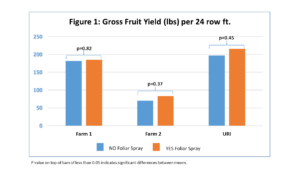
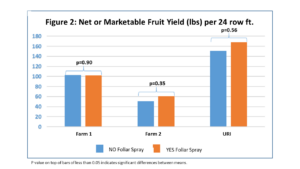
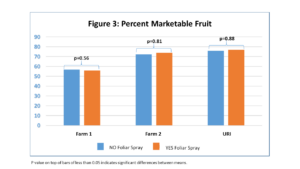
Problems encountered during the season are detailed in the methods section above. These problems likely affected the results in the following ways:
- Fewer foliar nutrient applications may have made effects (if there might have been any) less pronounced than might have been observed.
- Fewer runs of the experiment (both because of lack of seedlings for planned third plantings and mismarked trays used for the second URI planting) provided less evidence to base a definitive conclusion as to the efficacy of these foliar fertilizers.
- Regular fertigation by the grower, contrary to the plan that had been discussed, may have masked any effects of foliar nutrients, which added up to very small total quantities of additional applied nutrients in comparison to the pre-plant and fertigated quantities.
- The all-pervasive bacterial canker disease might well have so negatively affected plantings at the grower's fields that any effects of foliar fertilizer was undetectable. While the URI planting performed quite well, however, no gains were made in yield or quality with applied foliar fertilizer.
The quantities of nutrients applied per acre via foliar spray was very small, as can be seen in Table 1. Even if twice the number of sprays had been applied, the grand total would still have been a small fraction of normal quantities of nutrients used per acre to achieve respectable yields.
 The liquid concentrate nutrients used by this grower are very expensive: 275 gallon bulk tanks cost over $2,000 each. Most of volume of these tanks are used for fertigation, but it is convenient to add the liquid to spray tanks during routine fungicide spraying, so there is a prevailing idea that adding some nutrients to the tank "can't hurt." The cost per acre was not ascertainable in this project as the price information from the sales representative who provided the foliar product was not provided. Since there was no measured gain in using these products, it is clear that there was no profit increase from their use. In fact, under the conditions of the 2017 season, it is clear that the use of these products and the labor required to apply them cut into the profit margin of this tomato crop.
The liquid concentrate nutrients used by this grower are very expensive: 275 gallon bulk tanks cost over $2,000 each. Most of volume of these tanks are used for fertigation, but it is convenient to add the liquid to spray tanks during routine fungicide spraying, so there is a prevailing idea that adding some nutrients to the tank "can't hurt." The cost per acre was not ascertainable in this project as the price information from the sales representative who provided the foliar product was not provided. Since there was no measured gain in using these products, it is clear that there was no profit increase from their use. In fact, under the conditions of the 2017 season, it is clear that the use of these products and the labor required to apply them cut into the profit margin of this tomato crop.
Foliar nutrient spray trials
While significant differences between treatments were not detected at any of the three locations where the experiment was performed, it is premature to conclude that such foliar fertilizer applications have no efficacy. Such a study should be performed again in another growing season. Further work is planned for the 2018 season, but restricted to the URI Agronomy farm with a sequence of three plantings. The study will compare an untreated control to two versions of foliar feeding: a "conventional" foliar feeding plan using synthetic fertilizer products; and an organic foliar feeding plan as recommended by a consultant with knowledge of the products used and application protocol.
This study is facilitating the opening of a larger discussion with the grower about input expenses, including judicial use of appropriate fertigation products. It is difficult to find peer-reviewed data on the efficacy of zinc humate, or humates in general, in tomato production, but the grower has been encouraged to apply it to all of his crops, and he takes the sales representative's recommendation of it.
As of this time, the application of foliar nutrient sprays to determinate field tomatoes is not recommended unless there is a verified deficiency due to inability of roots to find that nutrient in the soil and there is a foliar nutrient application that has been shown to be effective in such a situation. Unless there is a serious root-uptake limitation, drip fertigation of an appropriate nutrient formulation will be recommended.
Foliar nutrient application survey
This survey of production practices was carried out at two conferences: The 2017 New England Vegetable and Fruit Conference in Manchester, NH, and at the 2018 Connecticut Vegetable and Small Fruit Grower’s Conference in Windsor, CT. Results of the field study were presented at the same time to these two audiences. A total of 76 growers filled out the survey.
The actual survey that was distributed is presented below, followed by graphic depictions of survey results, and commentary on each result. Here is a summary of findings:
• Nearly ¾ of respondents grow less than an acre of tomatoes
• Foliar feeding is a common practice: just over 50% of respondents have used the practice
• Most commonly consulted information sources on this practice is from other growers and sales reps
• Nearly 50% of those who practice foliar feeding do it routinely, rather than as needed
• The most commonly foliar fed crop grouping is tomato/pepper/eggplant, and of these, tomato is most likely responsible for the majority
• Most of the respondents do not send out leaf tissue for nutrient analysis; this is significant, given that it’s a very useful tool. Inconvenience and time lag may be reasons why not, though this was not a surveyed topic
• About ¼ of respondents regularly fertigate field determinate tomatoes; this is significantly low, given that for both organic and conventional growers, it is a very efficient system for nutrient delivery that reduces risk of leaching
• Among growers who do not foliar feed, routine fertigation is a slightly more common practice
The results of the field study indicate that, although there were a number of factors which may have obscured treatment differences during the 2017 growing season, it is unlikely that any foliar feeding which was performed would have influenced crop productivity or quality, though this will be further investigated in 2018. Nevertheless, foliar feeding is a common practice, according to the survey results. This suggests that practices commonly viewed as beneficial may not serve growers’ interests.
Below is the survey which had been distributed to growers, followed by graphic depictions of results and commentary on individual items. Question 10 in section one and Question 2 in section 2 were eliminated because of misunderstanding of the question. There are a number of substances that growers, especially those inclined towards organic methods, apply to foliage. Foliar fertilizer, as defined in the survey, is supposed to refer to materials with fertilizer analysis, but it appears from the variety of responses that there was confusion in this distinction in regards to these particular questions.
Your Farm and Foliar Feeding- Survey from the University of Rhode Island
Thanks for participating in this survey. Please do not supply your name. This information is being gathered to understand growers’ use of FOLIAR FEEDING. It will be used in future research.
If time is tight right now, you can mail this to Andy Radin, 3 East Alumni Ave, Kingston, RI 02881 OR Email andy_radin@uri.edu. I will send you a survey but not retain your name.
NOTES:
Foliar feeding refers to applying materials to plants that are labeled with a fertilizer analysis. This can include seaweed products that are labeled with a nutrient analysis.
Fertigation refers to the practice of applying fertilizer materials in irrigation water.
SECTION 1
1. How much land do you devote to field tomatoes?
a. 0 to ½ acre
b. >½ to 1 acre
c. >1 acre to 3 acres
d. >3 acre to 5 acres
e. >5 acres to 10 acres
f. >10 acres
2. How would you characterize your growing method/philosophy?
a. Certified organic
b. Not certified, but strictly organic in methods
c. Hybrid Conventional/Organic
d. Conventional
3. What state(s) do you grow in?
4. Have you ever applied foliar feed to vegetable crops?
a. YES
b. NO- SKIP to SECTION 2 on the other side of the page
5. How did you first find out about foliar feeding? (For example: non-extension website, grower magazine, sales rep, conference, etc.)
Please state sources
______________________________________________________________________________
______________________________________________________________________________
6. State your reason(s) for foliar feeding: (For example: correct known or suspected deficiency, routine practice all season, etc.)
______________________________________________________________________________
______________________________________________________________________________
______________________________________________________________________________
7. Has anyone advised you on specific foliar feeding practices? (For example: extension personnel, sales rep, another grower, etc.)
Sources of advice:
______________________________________________________________________________
______________________________________________________________________________
8. Circle vegetable crops that you foliar feed
a. Tomato/Pepper/Eggplant b. Cucumber/Squash/Pumpkin
c. Broccoli/Cauliflower/Brussels sprouts/Cabbage d. Collard/Kale
e. Sweet corn f. Onion/Leek/Garlic
g. Potatoes h. Beet/Chard
i. Salad greens
9. Do you use leaf tissue testing to make management decisions?
a. No
b. Once in a while just to check on things
c. Only when I suspect a deficiency
d. Yes, as part of routine management
10. Do you apply OTHER GROWTH PROMOTING SUBSTANCES as sprays (non-pesticides)? Please specify:
_____________________________________________________________________________________
_____________________________________________________________________________________
11. Do you fertigate determinate field tomatoes?
a. Never
b. Once or twice a season
c. Regularly
Thank you for participating in this survey!
SECTION 2
1. Why have you NOT used foliar feeding?
a. Wasn’t aware of the practice
b. No apparent need
c. Don’t believe there’s a benefit
d. It is not in accord with my production philosophy
2. Do you apply OTHER GROWTH PROMOTING SUBSTANCES as sprays (non-pesticides)? Please specify:
_____________________________________________________________________________________
_____________________________________________________________________________________
3. Do you fertigate determinate field tomatoes?
a. Never
b. Once or twice a season
c. Regularly
Thank you for participating in this survey!
SECTION 1
Question 1: How much land do you devote to field tomatoes?
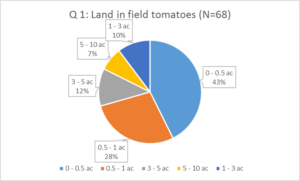
Comments: Nearly ¾ of respondents grow less than an acre of tomatoes
Question 2: How would you characterize your growing method/philosophy?
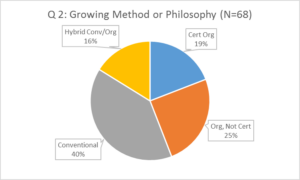
Comments: Nearly equal numbers of respondents characterize themselves as either organic or conventional, while a small contingent describes themselves as “hybrid”
Question 3: What state(s) do you grow in?
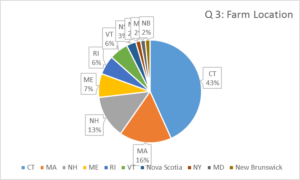
Comments: These surveys were conducted at two conferences, one based in CT for CT growers, and the other based in NH for growers from all over New England. CT, MA and NH make up the bulk of states represented.
Question 4: Have you ever applied foliar feed to vegetable crops?
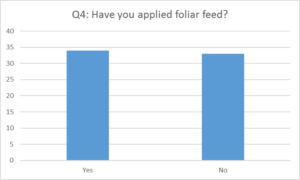
Comments: Approximately 50% of surveyed growers have practiced foliar feeding. It is therefore safe to say that this is a common, though not universally adopted practice.
Question 5: How did you first find out about foliar feeding? (For example: non-extension website, grower magazine, sales rep, conference, etc.)
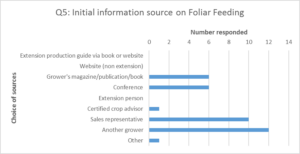
Comments: While a variety of responses were obtained, sales representatives and other growers were more common. Extension resources were not used.
Question 6: State your reason(s) for foliar feeding: (For example: correct known or suspected deficiency, routine practice all season, etc.)
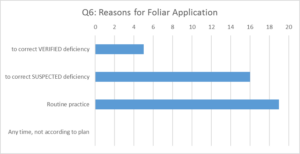
Comments: It can be gathered from this set of responses that foliar feeding is performed without verification of deficiencies.
Question 7: Has anyone advised you on specific foliar feeding practices? (For example: extension personnel, sales rep, another grower, etc.)
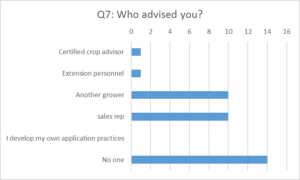
Comments: Like Question 5, responses demonstrate that growers follow advice of other growers or sales reps, or else experiment on their own.
Question 8: Circle the crops that you foliar feed
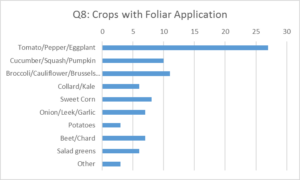
Comments: Many of the respondents circled more than one crop group. The most common are fruiting solanaceous vegetables, which is not surprising given the prevalence of tomatoes on small vegetable farms.
Question 9: Do you use leaf tissue testing to make management decisions?
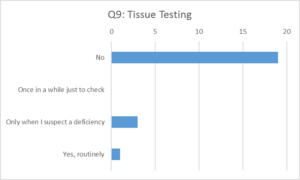
Comments: Given the results of Question 6, it is not surprising that the bulk of respondents do not use tissue testing to detect nutrient sufficiency/deficiency
Question 10: Do you apply OTHER GROWTH PROMOTING SUBSTANCES as sprays (non-pesticides)? Please specify:
Comments: Responses to this question were not worth reporting since there was confusion in differentiating between nutrient containing foliar materials and growth promoting substances like seaweed extracts and other materials.
Question 11: Do you fertigate field-grown tomatoes?
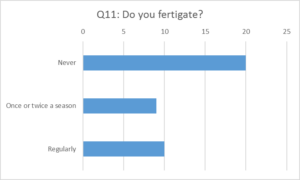
Comments: Fertigation is commonly practiced in high tunnels but is less common in field-grown tomatoes. However, many of the same materials used for fertigation are also used for foliar feeding, and the two are sometimes used in concert.
SECTION 2
Question 1: Why have you NOT used foliar feeding?
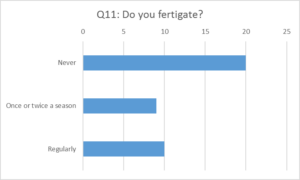
Comments: Almost 50% of these respondents were not aware of foliar feeding as a practice, which is in accord with Section 1, Question 4, in which approximately 50% stated they had not applied foliar feed ever.
Question 2: Do you apply OTHER GROWTH PROMOTING SUBSTANCES as sprays (non-pesticides)?
As in section 1, Question 10, this question resulted in a misunderstanding, so the question was eliminated.
Question 3: Do you fertigate determinate field tomatoes?
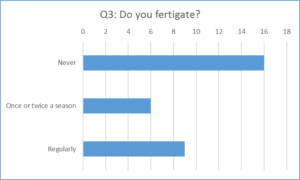
Comments: Among respondents who do NOT foliar feed, the three options were represented nearly identically as those who do foliar feed.
Education & Outreach Activities and Participation Summary
Participation Summary:
The research trial as it pertains to production practices has been discussed with several RI tomato growers (approx 10).
A frequent newsletter from URI Cooperative Extension directed at vegetable growers featured an article on foliar feeding and the research.
A group of master gardeners from RI saw the research in progress on a tour of the research farm.
Results from the field research were presented during the tomato session of the 2017 New England Vegetable and Fruit Conference (NEVFC) in Manchester, New Hampshire, on December 14 and again at the University of Connecticut Cooperative Extension Vegetable ad Small Fruit Conference on January 8, 2018. The former is a very large regional educational conference and expo and the latter is a single-room conference that attracted 245 attendees.
PDF of PPT presentation: Response-of-determinate-field-tomatoes-to-foliar-feeding1
Surveys were distributed to growers in the presentation rooms of both conferences to assess the interests and attitudes about foliar feeding. In total, 76 surveys were recovered.
The research in progress was featured during a twilight meeting for growers.
Learning Outcomes
I will be sitting down with the Confreda Family growers to discuss the project. Until I do so, I cannot state anything regarding their learning outcomes. I do hope to be discussing this practice with other RI growers during the winter and the coming growing season.
While information from this study has been shared with a number of growers, the cooperating grower was the major focus of attempts to change behavior. This change is significant for Rhode Island because the grower has more acres under cultivation than any other in the state. It was a difficult year in particular because of the bacterial canker disease, but he also was not impressed with the performance of foliar feeding on his own farm and has reconsidered his nutrient applications. There were many conversations with the owner's nephew, who is ascendant in the operation side of the business, and he is anxious to modify practices after our extensive contact during the summer of 2017. Over time, he seems to gain more influence in the production input decision making. Our discussions made him aware of some wasteful practices. Changes in behavior at this farm is a multi-year process and requires aggressive pursuit by extension personnel. The process continues.
Project Outcomes
Until I discuss the 2017 season project with the grower, the only outcome I can definitively state is that the Confredas (including Vinny Jr., Corey, Vinny III, and Jonathan) are very much thinking about their inputs and associated yields. They had a very poor season for tomatoes, which is their second highest grossing crop behind sweet corn. While the bacterial canker disease was partly responsible for the poor showing, the crop at URI was very respectable, both in quantity and quality. I would sooner attribute their bad season to poor soil health than to the disease infestation. Their soils are highly eroded and compacted, and they are not cover-cropping regularly. Their irrigation practice is also in need of rethinking.
Difficulties with methods are well documented in the Methods and Results sections of this report.
Working in growers fields can be challenging, though this varies between individual operations. Large operations carry much greater risk than smaller ones, and they may instinctively take precautions in their management. I believe that although Vinny Confreda told me that he was intending to cut way back on fertigations, his judgement was altered as it became clearer that his entire crop was afflicted with bacterial canker. This is something he can't be blamed for. Another phenomenon that affected the grower's judgement is that two agrichemical companies and his extension agent had his attention. The two sales reps had products to recommend, while my recommendations were largely oriented towards management modifications.